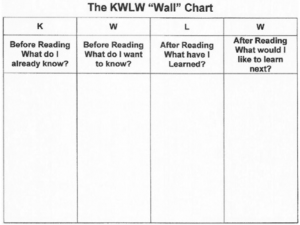
Here’s how to boost kids’ comprehension. Check out these classroom-perfected success secrets. A big help for Back-To- School gear up!
These strategies work with Non-fiction/infotext, a big focus in Common Core. Most kids K-8 benefit from many of my favorite activities.
As easy as A B C D E! #Let’s Plain Talk, Together!
What really matters to help kids understand what they read?
A. Make Connections.
- Start by connecting to the prior lesson, as a quick review.
- Find out what your child or students already know. This is called schema, or schemata (prior knowledge).
- SET the lesson or mini-lesson. This is the transition from the previous lesson and opens or hooks what you are teaching. Grabbers!
- Make sure your child knows why it’s important to learn and master the topic.
- Use the original KWL CHART (Donna Ogle) or my revised chart. I also make one with an extra column W at the end for Where will I find it?
There are other variations to the basic KWL strategy. Use whatever works best for you!
B. Before Reading Do This:
- Have a purpose for reading.
- Do a ‘Walk Through’, checking out the book or chapter.
- Make predictions about the selection.
- List any new vocabulary words.
- Organize the chapter titles and main headings.
- Write/ask questions what you want to learn.
C. During Reading Do This:
- Adjust rate or speed to match the reading level.
- Take notes, as Sketch Notes or whatever you like to do.
- Summarize as you go- chapter, paragraph or line.
- Answer questions you started with.
- CFU– Check For Understanding.
- Reread any sections you need to. Do retellings.
D. After Reading Do This:
- Find main ideas and details, look for topic sentences.
- Answer your questions after reading to see if your predictions were right.
- Sequence the reading selection, regarding importance and serial order.
- Summarize your reading, out loud and in writing.
- Look for any clarifications and inferences in the material.
- Use the new vocabulary routinely and correctly spell new words.
E. Final Tips:
- Use QAR’s: (Raphael). When responding to questions, it’s Literal– Right there; Interpretive– Look for it; and Inferences– Use prior knowledge to guess.
- Do PWR: Predict what the chapter, paragraph or page is about. Predict. Write. Read.
- Do RCRC: Read it. Cover or close the book. Recite what you read. Check. Open the book or selection to see if you’re right.
- Use basic Bloom’s Taxonomy. There are six levels:
- Knowledge: State the basic facts. Name, list, tell, define, describe.
- Comprehension: Understand the concept. Discuss, summarize, explain, demonstrate, review.
- Application: Use the information. Show, apply, produce, draw, select.
- Analysis: Check the parts. Compare, contrast, debate, classify, diagram.
- Synthesis: Put the information together. Design, create, construct, perform, organize.
- Evaluation: Form an opinion. Decide, conclude, rank, rate, prove.
Boost comprehension by having your own blueprint or roadmap to success! I hope these strategies are helpful as you fill your Back-To-School toolkit with ready- to- go ideas.
I’m here to answer your questions. I’d love to hear from you!
Be sure to check out my FB page and I’m on Twitter @RitaWirtz. #Let’s Plain Talk, Together.
Leaving footprints on your reading hearts, Rita

